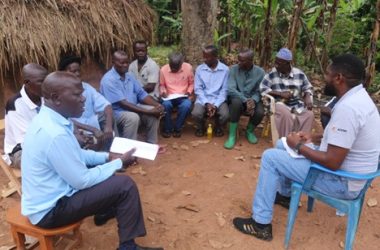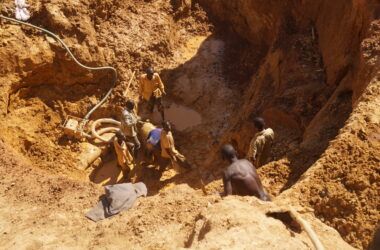Uganda’s gold exports hit $514 million last year raising excitement that majority of the players in the gold mining business, who are Artisanal and Small Scale Miners, are reaping big.
However, this boom has hardly reflected in the lives of ASMs in gold mining. For instance, the lives of residents of Chepkararat village, Lokales Parish, Karita sub-county in Amudat District, locals who have long survived on the gold in the sands of the Chepkararat river bed, remain the same.
When we visited last year, locals braved the sweltering sun digging the riverbeds and passing on the sand to colleagues for panning-a process where water is passed over the sands, draining it of soils and small stones, in order to expose the gold particles. Given that gold is a heavy metal, it tends to stay at the bottom of the solution when water is added to the sand.
One of the locals, who had been working the whole day, had only two miniscule particles—a yellowish and silver one—on the metallic pan for a day’s work. Apparently, the silver one had mercury in it and she would have to burn it when she got home to remove the mercury. It became clear, by the time she completed the process, her product would be too small and nearly invisible to the naked eye.
While this is not the case across all ASM gold sites in Uganda, it is a major pointer to why the millions of dollars from gold mining are not trickling to the artisans.
Apart from Karamoja, Uganda has since the 2010’s experienced a wave of a gold rush in Mubende, Mayuge, Namayingo, Bugiri and Karamoja, with tens of thousands of Ugandans flocking artisanal gold mines in search of a living.
Gold Witness in a 2016 report estimated that there were at least 50,000 artisanal gold miners in makeshift camps dotted on hillsides around the country and that they mined around three tonnes of gold per year.
While the price of gold on the international market is between $40m and $45m a tonne, locally artisans fetch about $30m per tonne. Given that rough estimate, their three tonnes per annum would fetch $90m. If one was to divide the $90m across 50,000 artisanal mines, each would get $1800 a year. But even this would be overstated given that middlemen often take the bulk of the money.
Yet in 2018 when Uganda earned $514m, thousands of ASMs that were evicted in Mubende had been out of action. Government evicted them on several grounds including invasion of gold deposits licenced to AUC mining, a registered company, among others.
Following the eviction, government pledged to register them in a bid to have their activities recognized legally and process location licences for them.
Since the year begun, the government has issued ASMs who had been evicted here with some 23 location licences according to Bukya John Bosco, who heads the Uganda Artisanal and Small Scale Miners Association (UGAASM). 30% of the mining areas in Mubende have been designated for the ASMs.
Since they were apportioned this land, however, they are yet post any serious results. They still do not have the appropriate equipment to aid them access gold or the finances to pay for government geological experts to survey the area.
Suspicions are rife that the gold rich areas have been given to private companies and investors, who are now operating on mine sites that were once under the management of ASMs.
But there is hope. The Mining and Mineral Policy outlines some solutions including capacity building, facilitation of access to credit, enhancing technology transfer and use of appropriate equipment for small-scale miners. But these are yet to be implemented.
“If we can organise our miners with government, and have them regulated, and give them licenses, they will be able to pay taxes and significantly contribute to the national budget,” Bukya believes.
Until then, however, the gold boom will be largely attributed to other players. One of these is the African Gold Refinery (AGR), a Belgian-owned refinery that has operated for a few years in Entebbe.
The company recently shipped from Venezuala gold worth $300m, surpassing US sanctions, and has also been accused of smuggling conflict gold from countries such as the Democratic Republic of the Congo (DRC).
While this was the single biggest shipment into and out of Uganda, the country’s gold exports have experienced a dramatic rise since the company set up shop in Uganda in 2014. In 2008, the country’s gold exports were only $10m.






